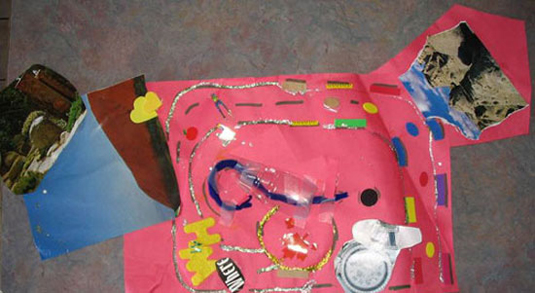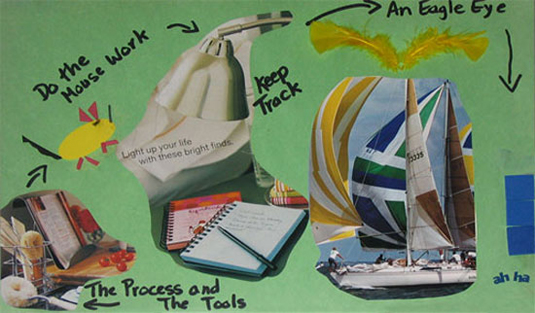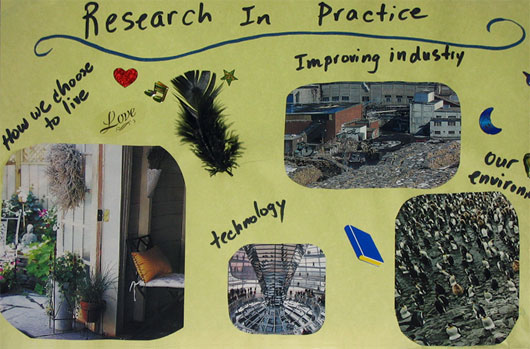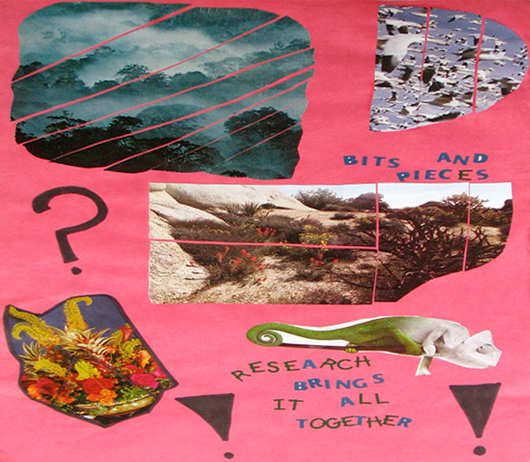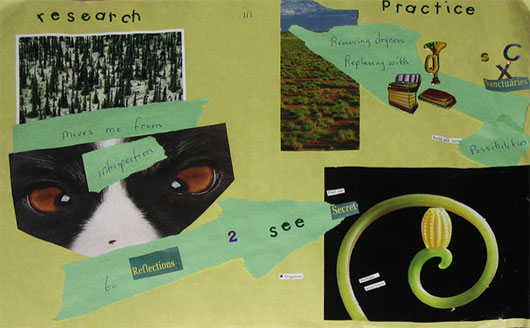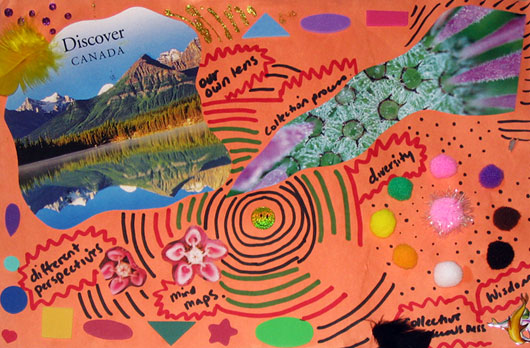|
Alberta Images of research in practice by Alberta practitioners These collages were created by: Connie Gross, Dawn, Julie, Kim Baxter, Lorene Anderson, Marilyn Luft, Susan Devins, Suzanne Koersen, and Valerie Neaves. Picture 1: Travel and tranquility
While you’re doing research you may sometimes feel like you’re looking through a looking glass. If you’re doing research in action with learners, the participants may feel like they’re being put through a looking glass. That’s actually what we’re doing—we’re looking at them through a looking glass, to get up close. One of the main reasons why we’re doing research in action is to find out how we can develop a better product or service for our learners, whether they are in the workplace or a traditional classroom. Research is a process. Ah, it’s a wonderful process but along the road many things happen. Sometimes you travel into the unknown. What seems like barren land can turn out to really be rich and full of wonderful experiences. To represent that we’ve included an image of Writing on Stone Provincial Park. The process of research may seem very foreign and the topic may seem very foreign. Sometimes you have to take a break, so we included an image of the tranquil spot. There is tranquility involved in research as you reflect upon your process. Toward the end of the research process there is congratulations. The winner is the learner or the person you are researching. Ultimately they benefit because the research is to develop a better product for them. If the W’s—where, what, who, what, when, where, why, how—are answered appropriately, the biggest winner is not just the learner. When the learner develops into a better student or worker, the workplace benefits and the economy benefits. Then everything benefits and we develop into a better Canada. Of course this all takes lots of time. Picture 2: Aha!
This collage outlines the process. It looks like a recipe. With research you gather your tools— how you’re going to gather and record your data. Then you go out and do your little mouse work. You find all the details and you gather all of the facts and make sure that, while you’re doing that, you keep track of everything that you do. You’ll shine the spotlight on some of the facts and details that you find as you go along. After you’ve gathered all of this you need to step back from all your details and facts and look at it with an eagle eye and spend some time reflecting. Hopefully that will lead you to an “Aha!” Picture 3: Quality of life
I thought, “What do we research?” We research how we choose to live… so, the quality of our lives. The reason we do research is so that we can have love, laughter and music—when we’re on key. We also research technology to improve industry and our environment. Picture 4: Unearthing the stars
First of all, research in practice is exciting. It’s learning new things. When I first I got a contract to do research, it was wonderful news. I couldn’t believe I was going to be paid to learn and talk to people and write it up! Research in practice also means going digging, delving beyond and beneath the surface. The candles show how enlightening it is. In research in practice you are learning—constantly turning over stones and finding new things. The frog goes in but also upward. One thing leads to another and you just keep learning new things. That’s why I included the feather—sometimes it’s hard to pin down. Research in practice keeps floating away, and out of your grasp. So it is ever-expanding, like the stars. Picture 5: Piecing together
To me these images all look the same: the forest clouded in fog, the flock of birds flying close together, and the desert. To show that they are bits and pieces of a whole, I cut each one into pieces. Sometimes in your classroom, things are missing or you have questions. When you research you put people together and you can make things seem exciting. To succeed at research you can morph into whatever you need to. That’s what the chameleon represents. Picture 6: It takes time
I started with light paper because if you start research with a bit of a blank slate you are able to be more objective. The timepiece represents how long it’s going to take and all the intricacies involved. Just looking at research takes time. Research happens in a lot of different ways. You’ve got to look beyond, look outside of, what you know. It can look different to a lot of different people. It is ever-changing, ever-evolving. Sometimes research pulls things apart and sometimes it brings things together. In research, you have to look at what’s been done before. There is a solid foundation but it can break apart in your plans. The tadpoles and frogs remind us that research can grow and might get out of control. You have to be able to bring it in again. Research means you have to ask lots of questions. But you also have to be passionate, full of heart and love. You have to do it with a smile on your face. Picture 7: Secrets and possibilities
When we start research, things can look like a big forest. We have to figure out where we’re going. But research can also move outwards from our inner selves. You do it one way, knowing it is the right way, and then you have to reflect. Often secrets get revealed when you sit back. They may be secrets in growth. Very delicate secrets, or thorny ones. After that you look around, to find out more. So we’re looking for secret possibilities. If we follow them, they can transform things. It’s like replacing drought with a beautiful landscape. Research becomes a sanctuary, too, because if everything is going well it’s a safe place, a learning place, and you’re at home. Picture 8:Curiosity, collaboration, caring, sharing
What does research in practice mean to me? You start with a question, a hunch, an idea, something that you want to explore. There are many different paths you might take in answering your question. And you involve participants and work together for one thing. Research is always a collaborative process. But research can be confusing. During the process there’s always a stage when you have a lot of information and you wonder what to do with it. Creating schematics can help you see where you’re at. Then you need to go back, reflect and evaluate. In the whole process there is lots of reflection. To do research you need to be inquisitive and have lots of energy. You always have to have fun, and of course you need caring. You need to care about your project, and care about the people you’re working with. In the end you end up with a report. Too often we don’t share what we learn with other people. We need to report and give them information. Picture 9: Challenges, delights, wisdom
This is very much like I feel in research in practice—very busy! I have to keep reminding myself that research comes through my own lens. We all come to research with different perspectives. It’s really important to honour all of them. But it’s also important to challenge ourselves to look at research from a new perspective, not just to stay with our own. Diversity and including people are important. Often times we end up with a large amount of data, as you all know. Then we have to crunch, crunch—get down to the real essence of the research. That phase is always challenging. But it is really important to me. At the end research gives us wonderful things. The feathers represent the collective consciousness from research. Then there’s just plain wisdom. It’s a really important word to me. I included it because I think we forget about wisdom in research. I don’t ever want to forget it. |

